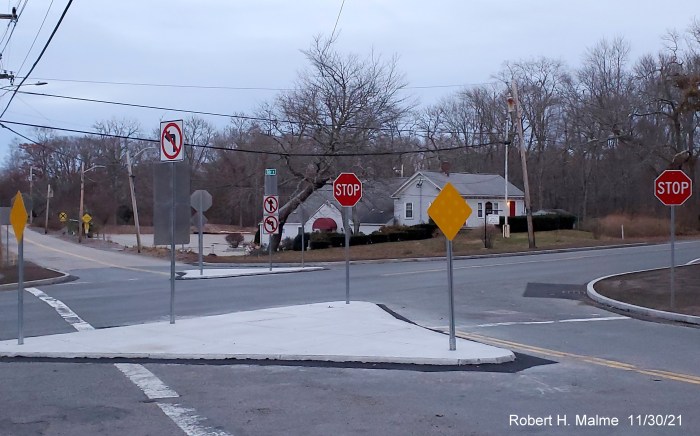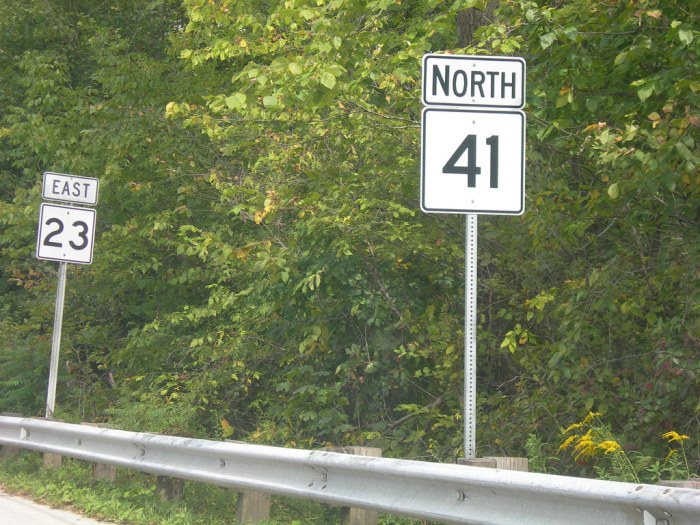Señales de tránsito en massachusetts – Traffic signs in Massachusetts play a crucial role in ensuring the safety and efficiency of the state’s roadways. They provide essential information, regulations, and warnings to drivers, helping them navigate the roads safely and comply with the law. This guide will provide a comprehensive overview of traffic signs in Massachusetts, covering their types, placement, visibility, and legal implications.
Massachusetts traffic signs are categorized into three main types: regulatory, warning, and guide signs. Regulatory signs impose specific rules or restrictions on drivers, such as speed limits, stop signs, and yield signs. Warning signs alert drivers to potential hazards or conditions ahead, such as curves, intersections, and pedestrian crossings.
Guide signs provide information and directions to drivers, such as route markers, destination signs, and informational signs.
Types of Traffic Signs in Massachusetts

Traffic signs in Massachusetts are an essential component of the state’s transportation system. They provide drivers with important information about road conditions, speed limits, and other regulations. There are three main categories of traffic signs: regulatory, warning, and guide signs.
Regulatory Signs
Regulatory signs are used to inform drivers of specific rules and regulations that they must obey. These signs are typically red, white, or yellow and have a distinctive shape. Some common examples of regulatory signs include:
- Stop signs
- Yield signs
- Speed limit signs
- No parking signs
Warning Signs
Warning signs are used to alert drivers to potential hazards on the road ahead. These signs are typically yellow and have a diamond shape. Some common examples of warning signs include:
- Curve signs
- Hill signs
- Slippery road signs
- Deer crossing signs
Guide Signs
Guide signs are used to provide drivers with information about directions, distances, and other helpful information. These signs are typically blue, green, or brown and have a rectangular shape. Some common examples of guide signs include:
- Exit signs
- Route number signs
- Distance signs
- Tourist attraction signs
Regulatory Traffic Signs
Regulatory traffic signs in Massachusetts are used to control the flow of traffic and ensure the safety of drivers and pedestrians. These signs convey specific regulations that drivers must obey, and violating these signs can result in fines, points on your license, or even more severe penalties.
Speed Limit Signs
Speed limit signs indicate the maximum speed at which vehicles are permitted to travel on a particular road or highway. Exceeding the posted speed limit is a common traffic violation and can result in fines and points on your license.
Stop Signs
Stop signs require drivers to come to a complete stop before proceeding through an intersection. Failing to stop at a stop sign is a serious traffic violation and can result in fines, points on your license, and even suspension of your license.
Yield Signs
Yield signs require drivers to slow down and yield the right-of-way to oncoming traffic before proceeding. Failing to yield can result in fines and points on your license.
Parking Restrictions
Parking restriction signs indicate areas where parking is prohibited or restricted. These signs may specify the days and times when parking is allowed, or they may indicate that parking is prohibited altogether. Violating parking restrictions can result in fines and towing of your vehicle.
Warning Traffic Signs

Warning traffic signs in Massachusetts aim to alert drivers of potential hazards or conditions ahead, providing them with ample time to adjust their driving behavior accordingly.
These signs typically indicate the presence of hazards such as curves, intersections, pedestrian crossings, or other potential dangers. By recognizing and responding to these warnings, drivers can enhance their safety and the safety of others on the road.
Types of Warning Signs
- Curve Warning Signs:These signs indicate the presence of a curve ahead, alerting drivers to reduce speed and proceed with caution.
- Intersection Warning Signs:These signs warn drivers of an upcoming intersection, prompting them to prepare for potential cross-traffic or stop signs.
- Pedestrian Crossing Signs:These signs indicate the presence of a designated pedestrian crossing,提醒 drivers to be aware of pedestrians and yield the right of way.
- School Zone Signs:These signs alert drivers to the presence of a school zone, requiring them to reduce speed and be extra cautious for children who may be present.
- Deer Crossing Signs:These signs warn drivers of areas where deer are known to cross the road, advising them to be alert and proceed with caution.
- Construction Zone Signs:These signs indicate the presence of a construction zone ahead, prompting drivers to slow down and be prepared for potential lane closures or detours.
- Slippery When Wet Signs:These signs warn drivers of road surfaces that become slippery when wet, advising them to reduce speed and exercise caution.
- Yield Signs:These signs indicate that drivers must yield the right of way to oncoming traffic before proceeding.
- Stop Signs:These signs require drivers to come to a complete stop before proceeding.
Guide Traffic Signs: Señales De Tránsito En Massachusetts

Guide traffic signs in Massachusetts play a crucial role in providing information and directions to drivers, helping them navigate the roadways safely and efficiently. These signs come in various forms, including route markers, destination signs, and informational signs.
Route Markers
Route markers indicate the route number and direction of travel on highways and major roads. They are typically rectangular or square in shape and feature black or white numbers on a colored background, such as blue, green, or red. Route markers help drivers stay on track and easily identify the routes they are traveling on.
Destination Signs
Destination signs provide information about upcoming exits, cities, towns, and other destinations. They are typically green and white in color and feature the name of the destination and the distance to it. Destination signs help drivers plan their trips and make informed decisions about their routes.
Informational Signs
Informational signs convey various types of information to drivers, such as upcoming road conditions, rest areas, and points of interest. They are typically blue and white in color and feature symbols or text to convey the message. Informational signs help drivers stay aware of their surroundings and make informed decisions while driving.
Traffic Sign Placement and Visibility

Traffic signs in Massachusetts are placed and maintained according to strict guidelines and regulations to ensure driver safety and compliance. Proper sign placement is crucial for providing motorists with timely and clear information about road conditions, hazards, and regulations.
Sign Placement Guidelines
* Signs should be placed at locations where they are easily visible to drivers.
- Signs should be placed at a height that is visible to drivers in all types of vehicles.
- Signs should be placed at a distance that allows drivers sufficient time to react to the information provided.
- Signs should be placed in a consistent manner throughout the state to avoid confusion.
Sign Visibility, Señales de tránsito en massachusetts
* Signs should be made of reflective materials to ensure visibility at night and in low-light conditions.
- Signs should be kept clean and free of obstructions.
- Signs should be illuminated when necessary to enhance visibility.
- Vegetation and other objects should be trimmed or removed to ensure clear visibility of signs.
Traffic Sign Compliance

Disobeying traffic signs in Massachusetts carries significant legal consequences. Failure to comply with traffic signs can result in fines, license suspension, and potential accidents.
Fines for traffic violations vary depending on the severity of the offense. Minor violations, such as failing to stop at a stop sign, typically result in fines of $100-$200. More serious violations, such as speeding or running a red light, can result in fines of $500 or more.
In addition to fines, traffic violations can also lead to license suspension. Repeat offenders or those who commit particularly egregious violations may have their licenses suspended for a period of time.
Perhaps the most important reason to obey traffic signs is for public safety. Traffic signs are designed to keep drivers, pedestrians, and cyclists safe. By following traffic signs, we can help to prevent accidents and save lives.
FAQ Resource
What are the different types of traffic signs in Massachusetts?
Traffic signs in Massachusetts are categorized into three main types: regulatory, warning, and guide signs.
What are the penalties for violating traffic signs in Massachusetts?
Violating traffic signs in Massachusetts can result in fines, license suspension, and potential accidents.
Where can I find more information about traffic signs in Massachusetts?
More information about traffic signs in Massachusetts can be found on the Massachusetts Department of Transportation website.